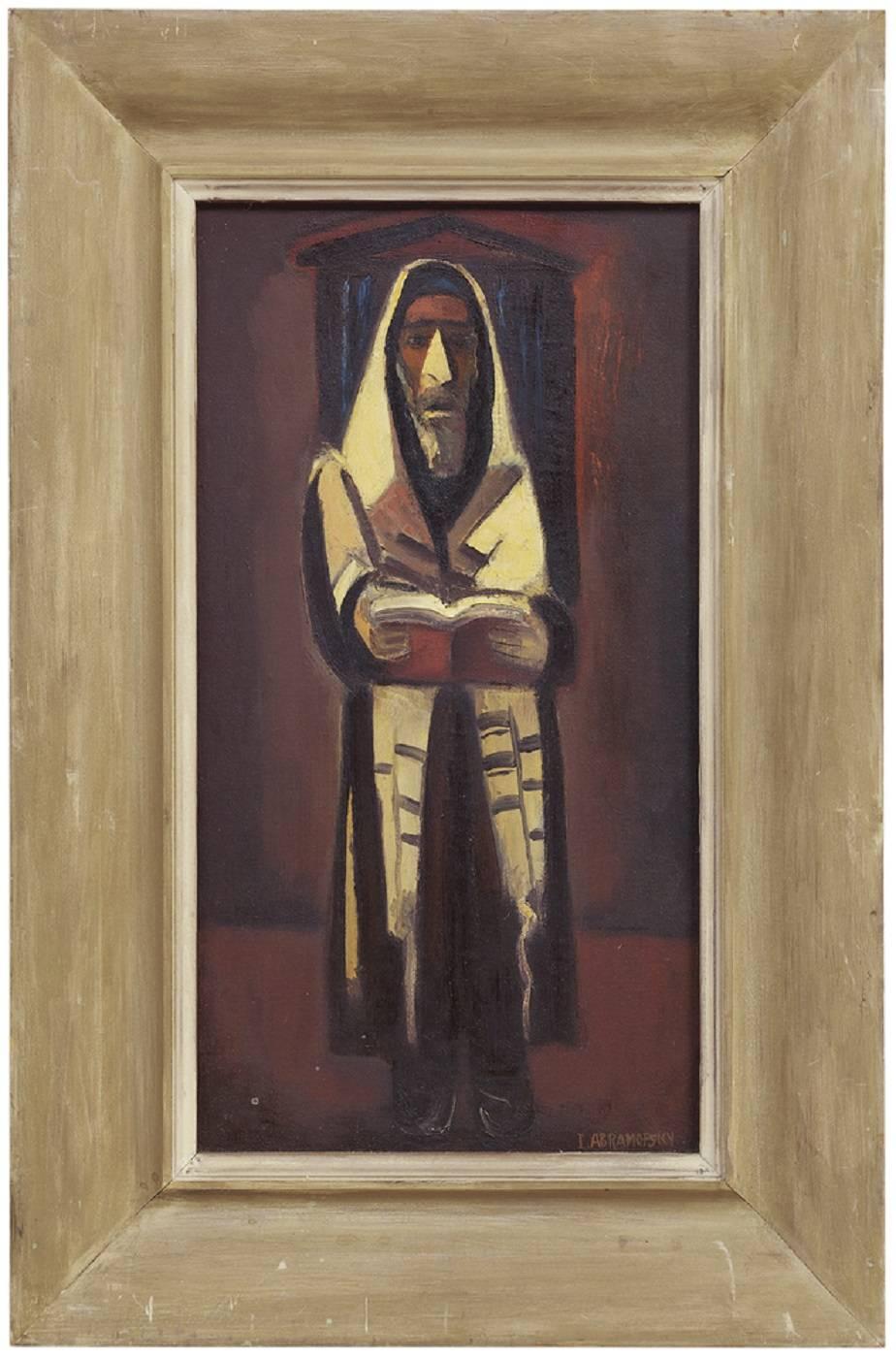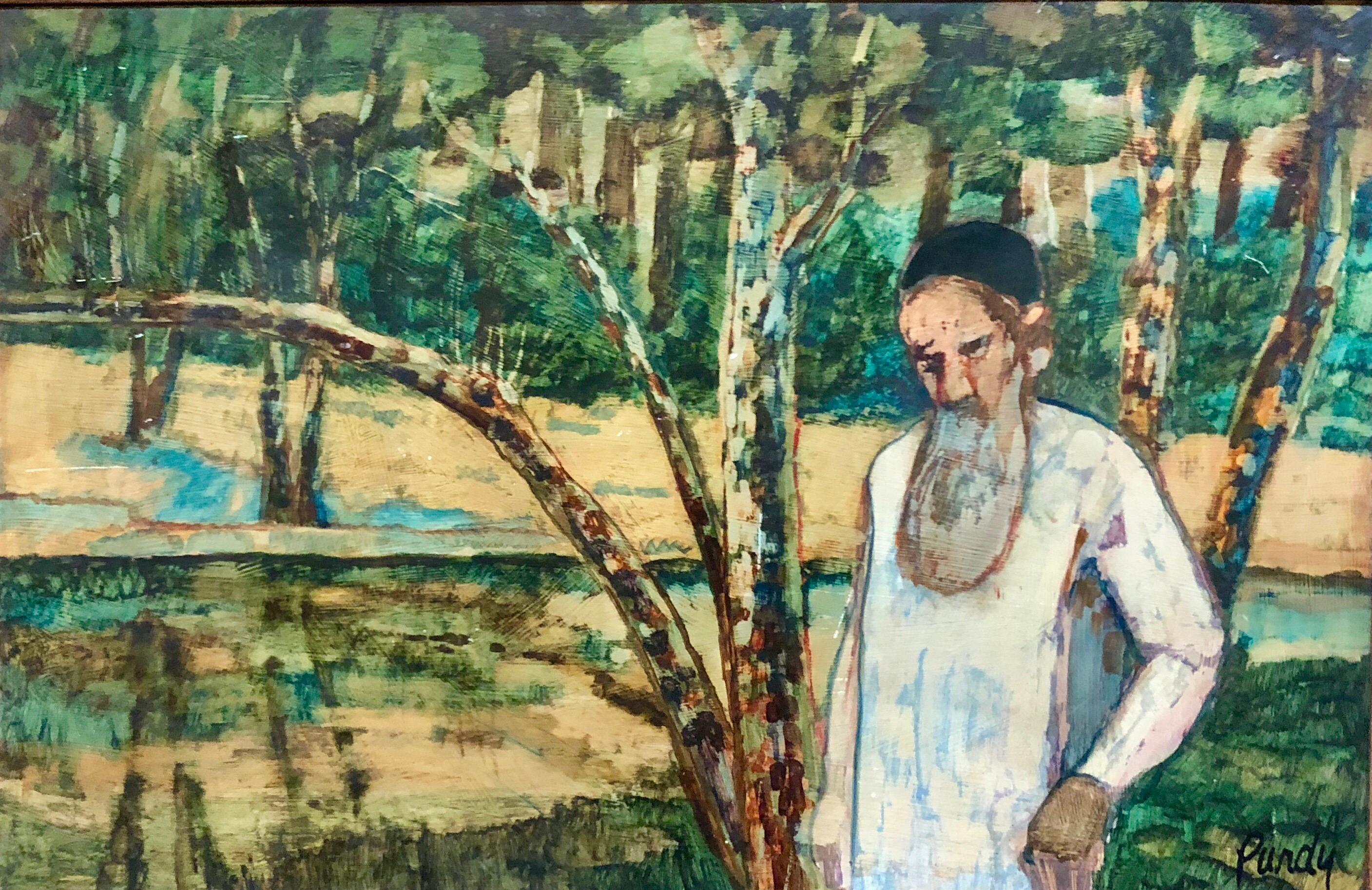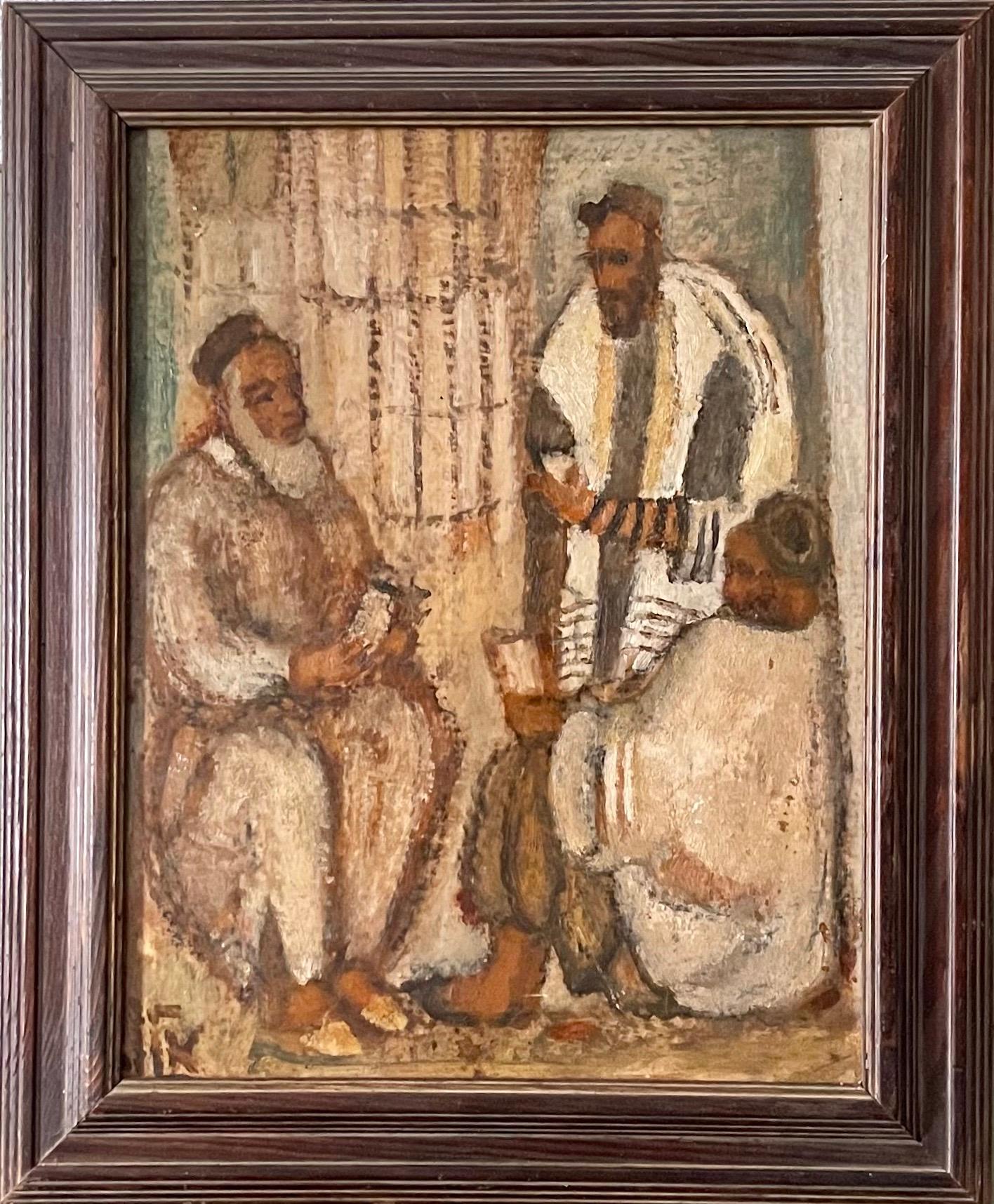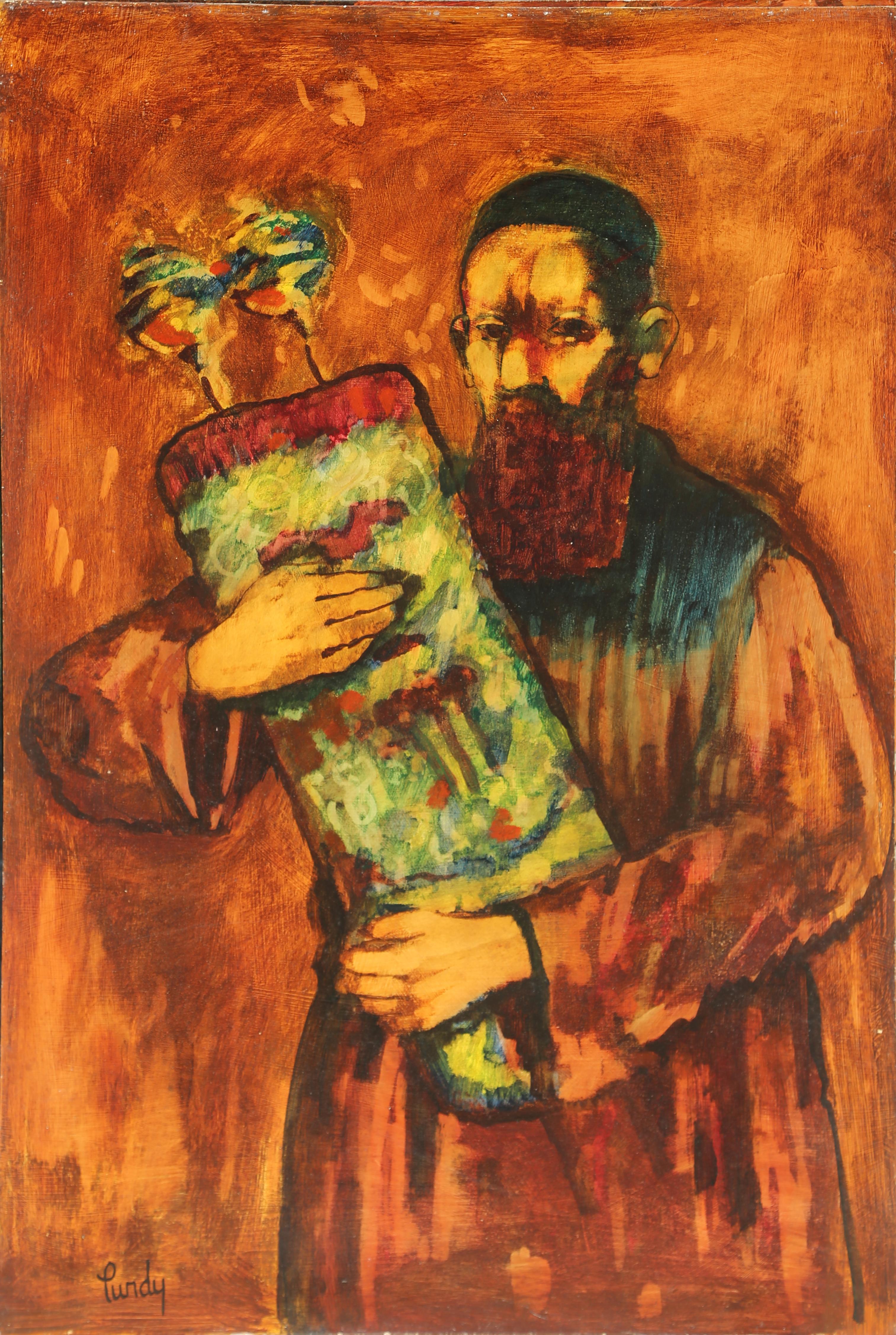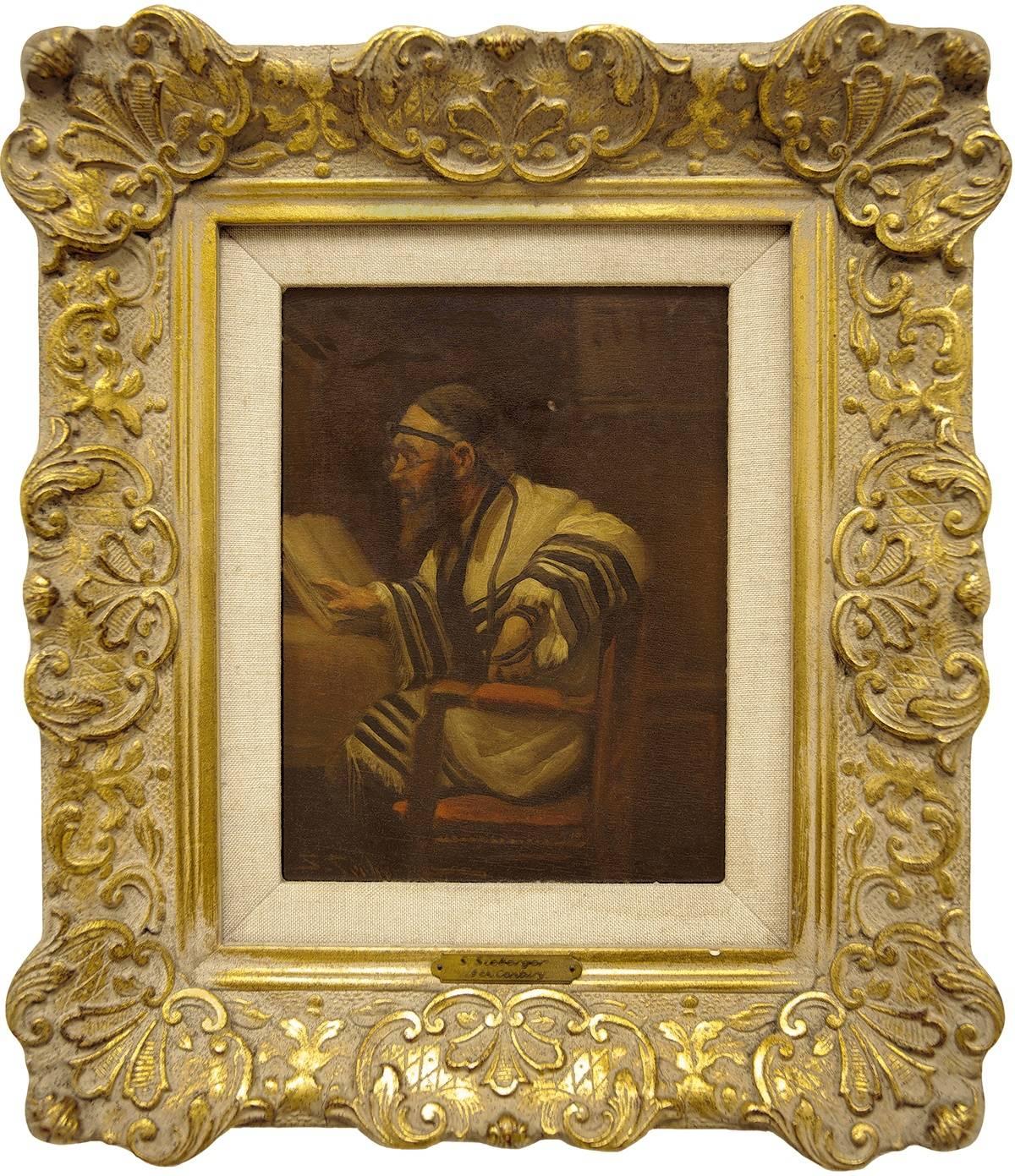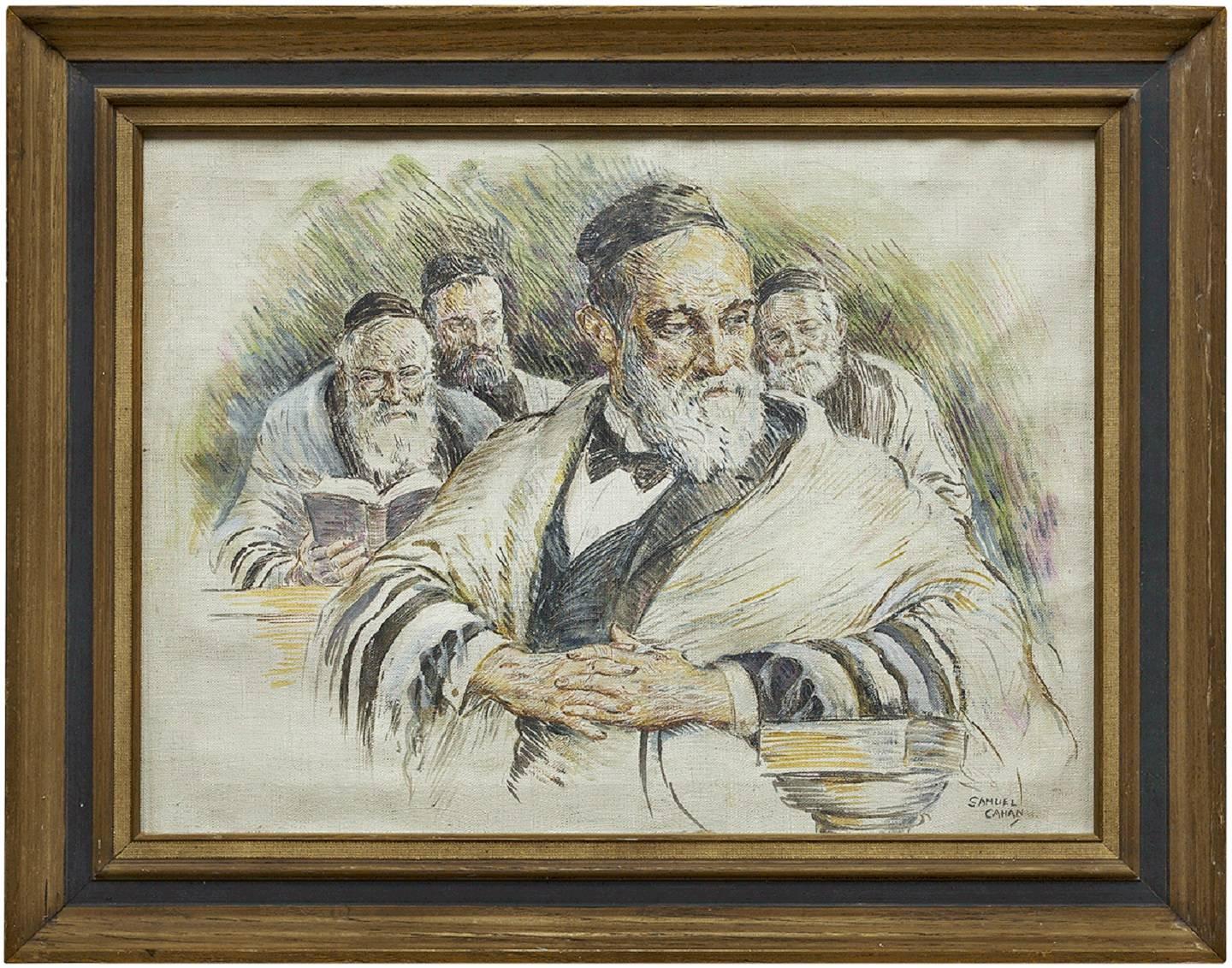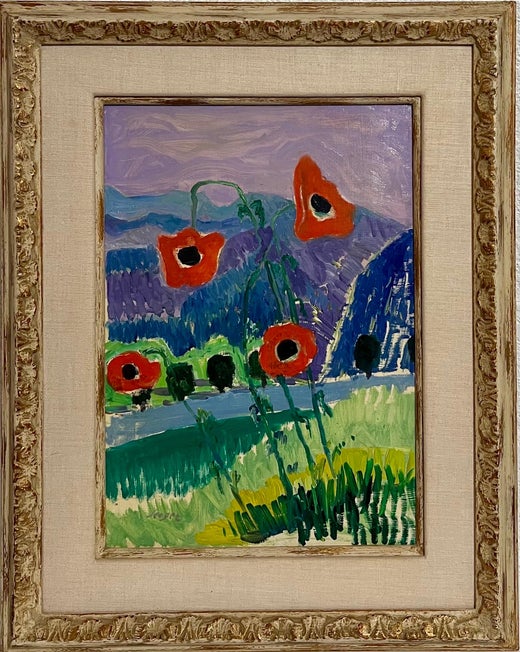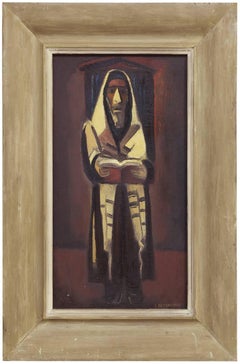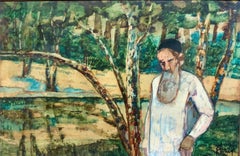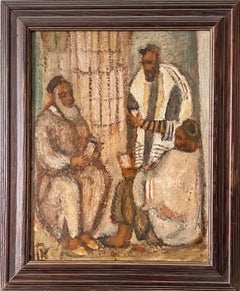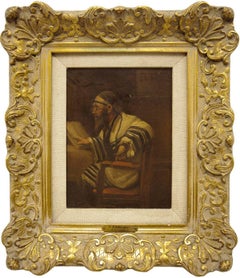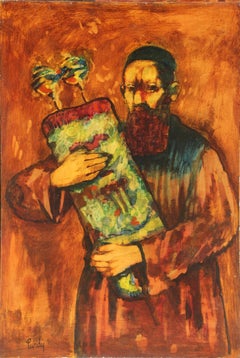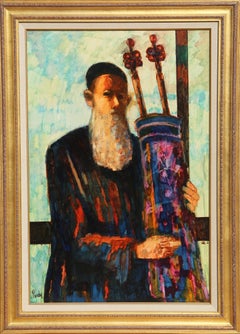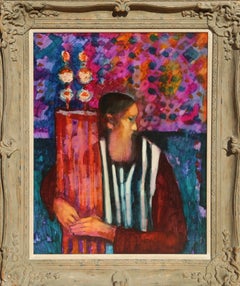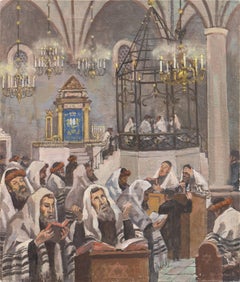Items Similar to Polish French Fauvist Judaica Oil Painting Rabbi at Prayer
Want more images or videos?
Request additional images or videos from the seller
1 of 8
Frederick B. SergerPolish French Fauvist Judaica Oil Painting Rabbi at Prayerc.1940s
c.1940s
$5,500
£4,175.51
€4,775.89
CA$7,684.30
A$8,546.62
CHF 4,462.78
MX$104,003.23
NOK 56,996.48
SEK 53,452.64
DKK 35,644.29
Shipping
Retrieving quote...The 1stDibs Promise:
Authenticity Guarantee,
Money-Back Guarantee,
24-Hour Cancellation
About the Item
Genre: Impressionist
Subject: People
Medium: Oil
Surface: Panel
Frederick Serger (given name Frederick Bedrick Sinaberger) was born in 1889 to a family of Jewish manufacturers in the village of Ivancice near Brno Moravia, a province of Czechoslovakia. Showing artistic talent at a young age, he attended art schools in Brno, Vienna, and Munich. During World War I, Serger joined the Austrian Army and served in the Balkans. Once his service ended, he traveled to Paris where he resumed his art training and eagerly joined the Ecole de Paris (School of Paris) artists’ movement. During this period, he was greatly influenced by the Impressionist, Post-Impressionist, and Expressionist movements.
While living in Paris, he met and married Helen Spitzer. Serger and his young wife moved from Paris to Scoczow, a city on the Polish-Czech border. They remained in Scoczow for 12 years and he continued to work as an artist, exhibiting in museums in Cracow and Warsaw, Poland. He also showed at the Paris Salon de Tuilleries and the Salon d’Automne with exhibitions protesting the French Academy’s Salon system. A high point in Serger’s career was an exhibition at the famed Bernheim-Jeune in Paris. The Bernheim-Jeune was known for displaying the artwork of premier artists such as Pablo Picasso and Paul Cezanne. Finally, in 1937, the City of Paris Museum purchased one of his paintings to be part of their collection.
During the onset of World War II, the Sergers moved several times, possibly in reaction to widespread Anti-Semitism during this period. They lived briefly in England, Panama, Guatemala, and Mexico. Finally, in 1941, they established permanent residence in Manhattan, New York. Serger set up a studio along 57th Street in Manhattan. Once again, he began painting prolifically and exhibiting his artwork in such prestigious galleries as Schoneman, Van Diemen-Lilienfeld and John Heller. His pieces were also displayed in major museums including the De Young Museum in San Francisco, the Museum of New Mexico in Santa Fe, the Springfield Art Museum and the Butler Institute of American Art in Ohio.
He studied art in Vienna, and in Munich with the Viennese Secessionists, served with the Austrian Army in World War One, went to Paris where he studied art and became part of the School of Paris (Ecole De Paris) movement, married Helen Spitzer, ( later Helen Serger owner of the Helen Serger, La Boetle Galleries in Manhattan) moved to Scoczow in Poland
until 1939, meanwhile exhibiting at many museums in Warsaw, Cracow, Salon de Tuilleries and at the famous Salon d'Automme, both in Paris regularly. In
1936 he had a one-man show at Salon and at Bernheim Jeune in Paris at a gallery historically noted for exhibiting many of the most important modern
painters such as Picasso and Cezanne. In 1937 the Museum of the City of Paris purchased a Serger from the Salon d'Automme. In 1939 he moved to
England and from there to Panama, Guatemala, and Mexico. In 1941 he established a studio on 57th St. in Manhattan and commenced a long career of exhibiting in New York Galleries such as, Lillenfelt Galleries, John Heller, Schoneman, a one-man show at De Young Museum in San Francisco and at the Museum of New Mexico in Santa Fe, at the Springfield Art Museum, and at the Butler Institute of American Art in Ohio; Serger participated in group
shows at the Mint Museum in Charlotte, Springfield Museum in Mass., Isaac Delgado Museum in New Orleans, Academy of Fine Arts in Hartford,
Norton Gallery in West Palm Beach, Carnegie Institute of Pittsburgh, Corcoran Gallery in Washington D.C., University of Illinois in Urbana,
Pennsylvania Academy of Art, Philadelphia, Detroit Institute of Art, Pennsylvania Academy of Fine Art, Philadelphia, Whitney Museum in New York andin countless other exhibits during the twenty-five years he lived and worked in New York. A listed Woodstock, NY artist. His biography is included in Who is Who in World Jewry and articles on his work appeared in many publications. FREDERICK SERGER HIS LIFE AND WORK by George Stiles
published by Schoneman, New York in 1962. He joined the Ecole de Paris (School of Paris) artists’ movement. During this period, he was greatly influenced by the Impressionist, Post-Impressionist, and Expressionist movements.
- Creator:Frederick B. Serger (1889-1965, American)
- Creation Year:c.1940s
- Dimensions:Height: 20 in (50.8 cm)Width: 16 in (40.64 cm)
- Medium:
- Movement & Style:
- Period:
- Condition:minor wear. paint loss around edge where it was under frame.
- Gallery Location:Surfside, FL
- Reference Number:1stDibs: LU38213146452
Frederick B. Serger
Frederick B. Serger (1889-1965) was an influential Polish-born painter known for his contributions to modern art. Born in Lwów, then part of the Austro-Hungarian Empire (now Lviv, Ukraine), Serger pursued his artistic education in Vienna and Munich, where he developed a distinctive style that melded traditional techniques with modernist sensibilities. His work, characterized by its vivid color palette and dynamic compositions, often depicted scenes of rural life, landscapes, and portraits, reflecting his deep connection to his heritage and the changing times. In the 1920s and 1930s, Serger's art gained considerable recognition in Europe, and he exhibited extensively in major cities including Paris, Berlin, and Vienna. The advent of World War II forced him to flee Europe, and he eventually settled in the United States. In America, Serger continued to paint and exhibit, adapting to his new environment while maintaining the unique style that had defined his earlier works. Serger's legacy lies in his ability to bridge European and American art traditions, creating a body of work that remains significant in the study of 20th-century art. His paintings are held in various private and public collections, serving as a testament to his enduring influence and artistic vision.
About the Seller
4.9
Platinum Seller
Premium sellers with a 4.7+ rating and 24-hour response times
Established in 1995
1stDibs seller since 2014
1,784 sales on 1stDibs
Typical response time: <1 hour
- ShippingRetrieving quote...Shipping from: Surfside, FL
- Return Policy
Authenticity Guarantee
In the unlikely event there’s an issue with an item’s authenticity, contact us within 1 year for a full refund. DetailsMoney-Back Guarantee
If your item is not as described, is damaged in transit, or does not arrive, contact us within 7 days for a full refund. Details24-Hour Cancellation
You have a 24-hour grace period in which to reconsider your purchase, with no questions asked.Vetted Professional Sellers
Our world-class sellers must adhere to strict standards for service and quality, maintaining the integrity of our listings.Price-Match Guarantee
If you find that a seller listed the same item for a lower price elsewhere, we’ll match it.Trusted Global Delivery
Our best-in-class carrier network provides specialized shipping options worldwide, including custom delivery.More From This Seller
View AllRabbi in Prayer, Judaica Oil Painting
By Israel Abramofsky
Located in Surfside, FL
Israel Abramofsky (September 10, 1888 - January 16, 1975) was a Russian-born artist, who trained in Paris and settled in the United States, known for his landscape works and works depicting Jewish life in Eastern Europe.
Abramofsky was born in Kiev, Russian Empire (present-day Ukraine) and left Czarist Russia...
Category
20th Century Figurative Paintings
Materials
Canvas, Oil
Judaica Meditative Rabbi at Prayer in Nature, Large Landscape Oil Painting
By Donald Roy Purdy
Located in Surfside, FL
Genre: Modern
Subject: Jewish Elder , Judaic Prayer
Surface: Board
Country: United States
signed lower left
Donald Roy Purdy is an American painter whose work evolved through a rang...
Category
20th Century Fauvist Figurative Paintings
Materials
Oil, Board
Synagogue Interior Jerusalem Modernist Israeli Judaica Oil Painting Rabbi Prayer
By Arieh Allweil
Located in Surfside, FL
ARIEH ALLWEIL (ARIE ALWEIL) 1901-1967
Galicia 1901-1967 Safed, Israel (Ukrainian/Polish/Israeli)
Arieh Allweil, born 1901, Galicia. Immigrated to Palestine in 1920. Studies: 1921-25...
Category
20th Century Modern Figurative Paintings
Materials
Canvas, Oil, Board
Rabbi In Prayer, Early 20th Century Oil Painting
By S. Sieberger
Located in Surfside, FL
Samuel Seiberger, (Seeberger) was a known artist and post-card designer who lived in Paris and was active circa 1900-1940. He was arrested for being a Jew when the Germans occupied Paris in the 1940s. He was brought into a concentration camp...
Category
Early 20th Century Modern Portrait Paintings
Materials
Oil
Vintage Illustration Judaica Painting, The Rabbi's (Men at Prayers)
By Samuel George Cahan
Located in Surfside, FL
Genre: Judaica
Subject: Religious
Medium: Oil
Surface: Canvas
Country: United States
Dimensions: 24" x 18" x 3/4"
Dimensions w/Frame: 29" x 23"
Cahan uses vibrant oil paint to draw a portrait of four elderly Jewish men wearing prayer shawls also known as tallits. The man in the foreground is staring pensively into the distance while the other figures in the background read or pray. Each character shares the same scholarly air in their serious expressions and mannerisms. Cahan’s gestural use of color and brush strokes soften the painting’s protagonists, thereby shedding a more sensitive light on the painting.
The well-known twentieth century American illustrator, etcher, and painter Samuel George Cahan was born in Kovno, Russia, now part of Lithuania. His parents were both born in Russia during the early 1870’s. Two years after his birth, his family emigrated to America and eventually settled in New York City's Lower East Side. Cahan said that his interest for drawing started when he was only an infant. In a 1967 interview, the artist describes his primary school years as vastly disinteresting. While other students heeded their teachers or studied math, Cahan drew.
At 12-years-old, Cahan exhibited his early talent for drawing on Fulton Street’s sidewalk. Barefoot and armed with chalk, he crouched outside a restaurant and drew the sinking of Maine. At the time, it was recognizable ship that was smashed by the British. One of the men who passed by his vibrant rendering of the wreckage was the Chief Editor of the New York World newspaper, Nelson Hersh. Upon seeing the young boy’s skill, Hersh offered him a job in the newspaper’s art...
Category
Mid-20th Century American Impressionist Figurative Paintings
Materials
Canvas, Oil
Rare Ecole De Paris Judaica Rabbin avec Torah (Rabbi with Torah) OIl Painting
By Simon Claude (Vanier) Abramovitch
Located in Surfside, FL
without frame it is 31.5 X 15.75 inches.
It is quite rare to find good Judaic Paintings by School of Paris listed artists. This is a particularly good piece of French Jewish art.
Category
Early 20th Century Post-Impressionist Figurative Paintings
Materials
Canvas, Oil
You May Also Like
Rabbi, Oil Painting by Donald Roy Purdy
By Donald Roy Purdy
Located in Long Island City, NY
Artist: Donald Roy Purdy, American (1924 - )
Title: Rabbi
Year: circa 1960
Medium: Oil on Masonite, signed l.r.
Size: 36 x 24 in. (91.44 x 60.96 cm)
Category
1960s Post-War Figurative Paintings
Materials
Masonite, Oil
$6,000 Sale Price
20% Off
Rabbi with Torah, 1970s Oil Painting by Donald Roy Purdy
By Donald Roy Purdy
Located in Long Island City, NY
Artist: Donald Roy Purdy, American (1924 - )
Title: Rabbi with Torah
Year: circa 1970
Medium: Oil on Masonite, signed l.r.
Size: 36 x 24 in. (91.44 x 60.96 cm)
Frame Size: 45 x 31 in...
Category
1970s Modern Figurative Paintings
Materials
Masonite, Oil
Rabbi, 1970s Oil Painting by Donald Roy Purdy
By Donald Roy Purdy
Located in Long Island City, NY
Artist: Donald Roy Purdy, American (1924 - )
Title: Rabbi with Torah
Year: circa 1970
Medium: Oil on Masonite, signed l.r.
Size: 30 x 22.5 in. (76.2 x 57.15 cm)
Frame Size: 38 x 31 i...
Category
1970s Modern Figurative Paintings
Materials
Masonite, Oil
'Interior of Synagogue with Rabbi', Polish Orthodox Judaica, Israel, Pentateuch
By Mieczyslaw Watorski
Located in Santa Cruz, CA
Signed lower right, 'M. Watorski' for Mieczyslaw Watorski (Polish, 1903 - 1979) and painted circa 1950.
This Polish history and landscape painter is particularly revered for his doc...
Category
1940s Modern Interior Paintings
Materials
Canvas, Oil
Rabbi holding the Torah, Oil Painting by Donald Roy Purdy
By Donald Roy Purdy
Located in Long Island City, NY
Artist: Donald Roy Purdy, American (1924 - )
Title: Rabbi 3
Year: circa 1970
Medium: Oil on Masonite, signed l.r.
Size: 30 x 24 in. (76.2 x 60.96 cm)
Frame Size: 38 x 31 inches
Category
1970s Modern Figurative Paintings
Materials
Masonite, Oil
Rabbi and Torah, Oil Painting by Abraham Straski
By Abraham Straski
Located in Long Island City, NY
Artist: Abraham Straski, Polish (1903 - 1987)
Title: Rabbi and Torah
Year: circa 1957
Medium: Oil on Canvas, signed l.r.
Image Size: 16 x 12 inches
Frame Size: 26 x 20 inches
Category
1950s Post-War Portrait Paintings
Materials
Canvas, Oil
More Ways To Browse
Frederick Fine Art
Pablo Picasso Oil On Canvas
C Manning Oil Painting On Canvas
Panama Painting
C Francisco Oil On Canvas
Oil Painting Of George Washington
Modern Judaica Painting
Mexican Village Paintings
Rabbi Painting
Painting Of Rabbi
Art Of Panama City
Jewish Rabbi Painting
Oil Paintings Of Jewish Man
Judaica Oil Painting
Helen Young
Polish Jewish Art
Frederick Ii
Polish Jewish Artist
